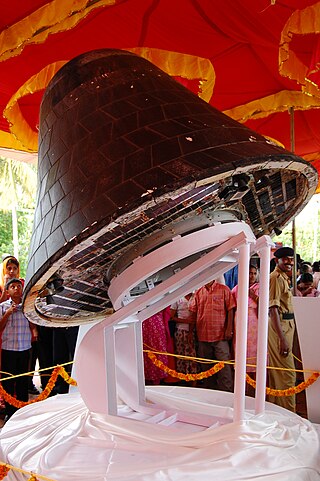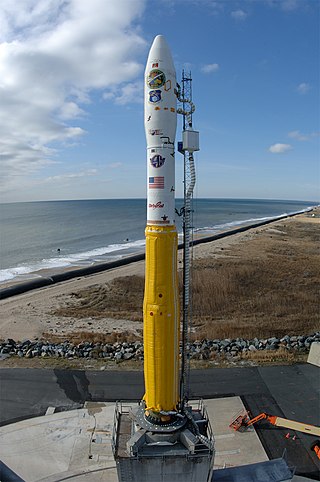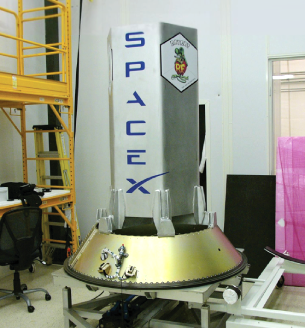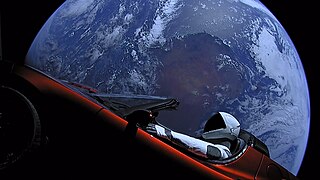| Mission type | Plasma research |
|---|---|
| Operator | USAF Academy |
| Mission duration | Failed to orbit |
| Spacecraft properties | |
| Manufacturer | SSTL (bus) |
| Launch mass | 19.5 kilograms (43 lb) |
| Start of mission | |
| Launch date | 24 March 2006, 22:30 UTC |
| Rocket | Falcon 1 |
| Launch site | Omelek |
| Contractor | SpaceX |
| Orbital parameters | |
| Reference system | Geocentric |
| Regime | Low Earth |
| Perigee altitude | 400 kilometres (250 mi) |
| Apogee altitude | 500 kilometres (310 mi) |
| Inclination | 39 degrees |
| Epoch | Planned |
FalconSAT-2 (FS 2, COSPAR 2006-F01) was a satellite built by students of the United States Air Force Academy as part of the FalconSAT program. It was intended to have been placed into low Earth orbit to study the effects of plasma on communications with spacecraft, [1] however it failed to reach orbit due to a malfunction of its carrier rocket. [2]
The FalconSAT-2 program started in late 2000, as a follow-up to FalconSAT-1. [2] The spacecraft was based on a bus constructed by Surrey Satellite Technology Ltd, with the experiments being constructed at the USAF Academy. [2] The primary instrument aboard FalconSAT-2 was the Miniaturized Electrostatic Analyzer, or MESA. It was originally scheduled to be deployed from Space Shuttle Atlantis, on mission STS-114 in early 2003. Following the Columbia accident this mission was delayed, and FalconSAT-2 was removed from the Shuttle manifest.
It was then assigned as the payload for the maiden flight of the Falcon 1 rocket, which was launched from Omelek Island at 22:30 GMT on 24 March 2006. [3] At launch, a corroded nut caused an engine fire, leading to the failure of the engine 25 seconds into the flight. [4] The rocket fell into the Pacific Ocean close to the launch site. FalconSAT-2 was thrown clear of the rocket, and landed in a storage shed on Omelek Island, just a few feet from its own shipping container. [2]

A spaceplane is a vehicle that can fly and glide like an aircraft in Earth's atmosphere and maneuver like a spacecraft in outer space. To do so, spaceplanes must incorporate features of both aircraft and spacecraft. Orbital spaceplanes tend to be more similar to conventional spacecraft, while sub-orbital spaceplanes tend to be more similar to fixed-wing aircraft. All spaceplanes to date have been rocket-powered for takeoff and climb, but have then landed as unpowered gliders.

Falcon 1 was a small-lift launch vehicle that was operated from 2006 to 2009 by SpaceX, an American aerospace manufacturer. On 28 September 2008, Falcon 1 became the first privately developed fully liquid-fueled launch vehicle to go into orbit around the Earth.

The Boeing X-37, also known as the Orbital Test Vehicle (OTV), is a reusable robotic spacecraft. It is boosted into space by a launch vehicle, then re-enters Earth's atmosphere and lands as a spaceplane. The X-37 is operated by the Department of the Air Force Rapid Capabilities Office, in collaboration with United States Space Force, for orbital spaceflight missions intended to demonstrate reusable space technologies. It is a 120-percent-scaled derivative of the earlier Boeing X-40. The X-37 began as a NASA project in 1999, before being transferred to the United States Department of Defense in 2004. Until 2019, the program was managed by Air Force Space Command.

FalconSAT is the United States Air Force Academy's (USAFA) small satellite engineering program. Satellites are designed, built, tested, and operated by Academy cadets. The project is administered by the USAFA Space Systems Research Center under the direction of the Department of Astronautics. Most of the cadets who work on the project are pursuing a bachelor of science degree in astronautical engineering, although students from other disciplines join the project.

The year 2007 contained several significant events in spaceflight, including a Chinese ASAT test, the launches of the US Phoenix and Dawn missions to study Mars and Asteroid belt respectively, Japan's Kaguya Lunar orbiter, and the first Chinese Lunar probe, Chang'e 1.

The Minotaur I, or just Minotaur is an American expendable launch system derived from the Minuteman II missile. It is used to launch small satellites for the US Government, and is a member of the Minotaur family of rockets produced by Orbital Sciences Corporation.

The year 2008 contained several significant events in spaceflight, including the first flyby of Mercury by a spacecraft since 1975, the discovery of water ice on Mars by the Phoenix spacecraft, which landed in May, the first Chinese spacewalk in September, the launch of the first Indian Lunar probe in October, and the first successful flight of a privately developed orbital launch vehicle by SpaceX's Falcon 1.
The Space Test Program (STP) is the primary provider of spaceflight for the United States Department of Defense (DoD) space science and technology community. STP is managed by a group within the Advanced Systems and Development Directorate, a directorate of the Space and Missile Systems Center of the United States Space Force. STP provides spaceflight via the International Space Station (ISS), piggybacks, secondary payloads and dedicated launch services.

Several significant events in spaceflight occurred in 2009, including Iran conducting its first indigenous orbital launch, the first Swiss satellite being launched and New Zealand launching its first sounding rocket. The H-IIB and Naro-1 rockets conducted maiden flights, whilst the Tsyklon-3, Falcon 1 and Ariane 5GS were retired from service. The permanent crew of the International Space Station increased from three to six in May, and in the last few months of the year, Japan's first resupply mission to the outpost, HTV-1, was conducted successfully.

This comparison of orbital launch systems lists the attributes of all individual rocket configurations designed to reach orbit. A first list contains rockets that are operational or in development as of 2023; a second list includes all upcoming rockets and a third list includes all retired rockets For the simple list of all conventional launcher families, see: Comparison of orbital launchers families. For the list of predominantly solid-fueled orbital launch systems, see: Comparison of solid-fueled orbital launch systems.

USA-212 was the first flight of the Boeing X-37B Orbital Test Vehicle 1, an American robotic vertical-takeoff, horizontal-landing (VTHL) spaceplane. It was launched aboard an Atlas V rocket from Cape Canaveral on 22 April 2010, and operated in low Earth orbit. Its designation is part of the USA series.

RatSat or DemoSat was an aluminum mass simulator on the fourth flight of the Falcon 1 rocket, launched on 28 September 2008. Ratsat remained bolted to the second stage of the carrier rocket after reaching low Earth orbit. It is an aluminium alloy chamber in hexagonal prism shape with 1.5 m (5 ft) length.

The year 2011 saw a number of significant events in spaceflight, including the retirement of NASA's Space Shuttle after its final flight in July 2011, and the launch of China's first space station module, Tiangong-1, in September. A total of 84 orbital launches were conducted over the course of the year, of which 78 were successful. Russia, China and the United States conducted the majority of the year's orbital launches, with 35, 19 and 18 launches respectively; 2011 marked the first year that China conducted more successful launches than the United States. Seven crewed missions were launched into orbit during 2011, carrying a total of 28 astronauts to the International Space Station. Additionally, the Zenit-3F and Long March 2F/G carrier rockets made their maiden flights in 2011, while the Delta II Heavy made its last.
Orion 3 was an American spacecraft which was intended for use by Orion Network Systems, as a geostationary communications satellite. It was to have been positioned in geostationary orbit at a longitude of 139° East, from where it was to have provided communications services to Asia and Oceania. Due to a malfunction during launch, it was instead delivered to a useless low Earth orbit.

USA-226 was the first flight of the second Boeing X-37B, the Orbital Test Vehicle 2, an American unmanned robotic vertical-takeoff, horizontal-landing spaceplane. It was launched aboard an Atlas V rocket from Cape Canaveral on 5 March 2011, and landed at Vandenberg Air Force Base on 16 June 2012. It operated in low Earth orbit. Its mission designation is part of the USA series.

Several new rockets and spaceports began operations in 2016.
USA-221, also known as FalconSat-5, is an American military minisatellite, which was launched in 2010. The fifth FalconSat spacecraft to be launched, it carries four technology development and ionospheric research experiments. The satellite was constructed and is operated by the United States Air Force Academy.

This article documents notable spaceflight events during the year 2018. For the first time since 1990, more than 100 orbital launches were performed globally.
USA-184, also known as NRO Launch 22 or NROL-22, is an American signals intelligence satellite, operated by the National Reconnaissance Office. Launched in 2006, it has been identified as the first in a new series of satellites which are replacing the earlier Trumpet spacecraft.